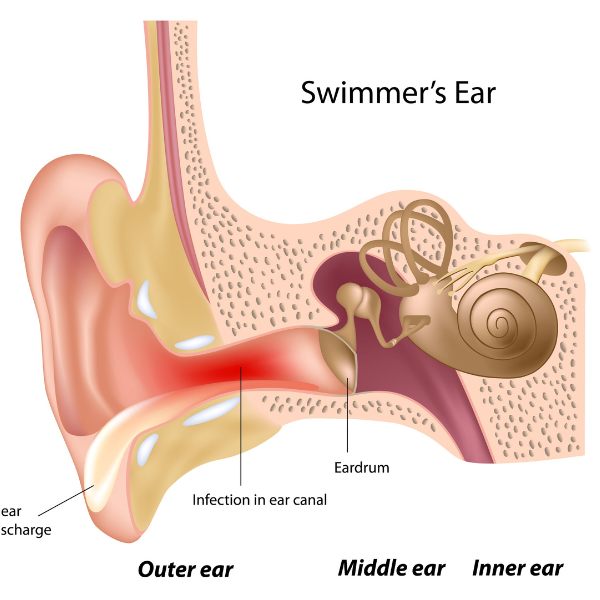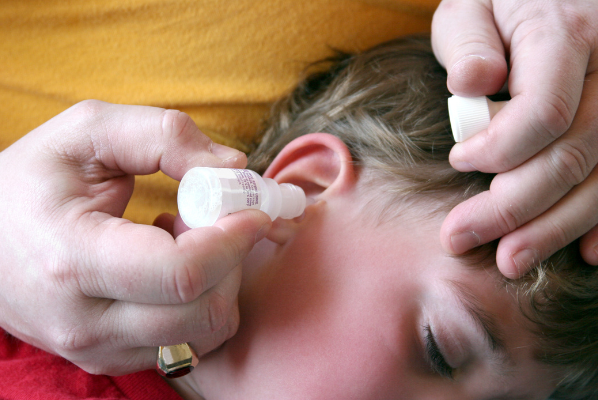July 1, 2025
Swimmer’s Ear: What It Is and How to Treat It
If you’ve ever had pain in your ear after swimming, you might have had swimmer’s ear. This is a common infection that affects the outer ear canal. It can happen to anyone, but it’s most common in children and teens who spend time in pools, lakes, or oceans.
Here’s what you need to know about swimmer’s ear, including causes, symptoms, how to prevent it, and when to visit Immediate Care.

What Causes Swimmer’s Ear?
The inner and outer ear are separated by the eardrum. The outer ear protects itself with a thin lining and earwax, which helps remove dirt, debris, and dead skin.
Swimmer’s ear, or otitis externa, is an infection of the outer ear. Swimmer’s ear happens when the ear’s natural defenses don’t work well. Moisture (usually from swimming or bathing) can sometimes become trapped in the outer ear canal, which creates a warm, damp space where bacteria can grow and then cause an infection.
According to the Mayo Clinic, swimmer’s ear is more likely when there’s moisture in the ear, contact with dirty water, or damage to the skin inside the ear (often caused by scratching or using cotton swabs).
What Are the Symptoms of Swimmer’s Ear?
Swimmer’s ear symptoms usually start mild but can get worse if not treated. Common signs include:
- Ear pain, especially when you tug the ear or lie on it
- Itching in the ear
- Redness or swelling around the ear
- Drainage from the ear that may be clear or yellow
- A feeling of fullness in the ear
- Trouble hearing clearly
In more serious cases, pain can spread to the face, neck, or side of the head.
When To Seek Care and How Swimmer’s Ear Is Treated?
Come to Immediate Care if you or your child has:
- Ear pain that gets worse
- Drainage that smells bad
- Trouble hearing
- Swelling around the ear or jaw
Quick treatment can stop the infection from getting worse.

At Immediate Care, treatment for swimmer’s ear usually starts with a physical exam. We’ll look inside your ear to check for signs of infection.
If it’s swimmer’s ear, we may:
- Clean the ear if needed
- Prescribe antibiotic ear drops to stop the infection
- Recommend pain relievers for comfort
- Give tips to keep the ear dry during healing
In most cases, swimmer’s ear improves within a few days of starting treatment. It’s important to follow the full course of medicine, even if you start to feel better. If you are diagnosed with a swimmer’s ear, we also recommend you try your best to not get water in the ear again until the infection resolves, which may mean taking a short break from swimming.
How to Prevent Swimmer’s Ear
You can lower your risk of getting swimmer’s ear by keeping your ears dry and clean:
- Use a towel to dry your ears after swimming or bathing
- Do not put objects like cotton swabs in your ears because you can cause damage to the ear canal or eardrum.
- Try tipping your head to the side to let any persistent water drain out
- Use earplugs or a swim cap to protect your ears when swimming
- You can also ask your doctor about special ear drops that can help dry out your ears when you get moisture in them.
Stay Safe this Swim Season
Swimmer’s ear is common, but it’s easy to treat and prevent. If you notice swimmer’s ear symptoms, don’t wait. Visit us at Immediate Care for one of our five locations or skip the trip with a virtual appointment. We’re here to help you feel better fast, so you can enjoy the water without worry.
 Troy Robinson, PA is in practice at each of Immediate Care's five locations in Nashua South, Nashua West, Pelham, Hudson, New Hampshire, and Pepperell, Massachusetts.
Troy Robinson, PA is in practice at each of Immediate Care's five locations in Nashua South, Nashua West, Pelham, Hudson, New Hampshire, and Pepperell, Massachusetts.
